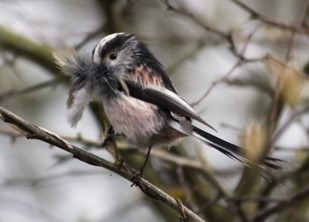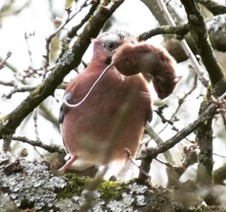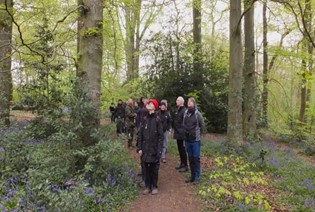
Conservation Report
YTD 2022

WCWT COnservation Report YTD 2022
Jan:
As what had been quite a mild winter continued into the New year the numbers of our migrant birds were well down on what we would expect to see, there were a few small flocks of Redwing briefly visiting the woodland but one of my favourite winter thrushes the Fieldfare seeming almost non-existent! Even the numbers of Blackbirds seemed to be low as many of you may have noticed in your gardens.
Feb:
February continued in much the same way as January with not really a lot happening until the middle of the month when the winter storms arrived, thankfully we didn’t come off to badly with only a couple of trees brought down, thankfully our ancient Beech trees in Stelley wood escaped the high winds without loss this year. One of the more interesting sightings I witnessed was one of our woodland Jay’s successfully hunting a mouse in the wetland area, this is very unusual behaviour for them to take a mammal and something that has seldom been witnessed.
March:
As March arrived things started to happen around the woodland with new life emerging as Snowdrops bloomed and the trees started to bud, I noticed the Frogs spawning on March 5th in the wetland which was around a week earlier than the previous year, unfortunately despite the signage at the wetland entrance some woodland uses were still allowing their dogs into the water which obviously isn’t good for the frogs! As the month progressed and the weather started to warm the woodland birds really begun to get ready for the breeding season with bird song filling the air as they marked their territories, please remember that many of our woodland bird’s nest on or very close to the ground and often can be found close to the paths so please take extra care not to disturb them at this critical time of year. Towards the end of the month our summer migrants started to arrive back to breed with Chiffchaff’s singing to mark for me the start of Spring.
April:
We had a very dry and cool April which seemed to slow off much of the spring growth, this however did give our Bluebells an extended life as the canopy didn’t fill as quickly letting more light into the woodland floor resulting in an excellent if a little later showing than usual. As the hedgerows and undergrowth started to grow, we saw more of our woodland Butterflies taking to the wing, this year seemed particularly good for Orange tips which could be seen on the main food plant for the larvae Jack of the hedge “Garlic Mustard” these Butterflies really are a sign that spring has arrive and only have the one brood per year.
One sad thing that came to light in April was the discovery of 2 dead Buzzards and a dead Tawny Owl at the nearby Waingroves hall, all 3 birds being found within a few days, this was reported and the RSPB investigations officer and the Police rural crimes officer both attended to collect the birds all of which were acceptedby the WIIS testing scheme. Unfortunately, this will take several months but is the best way to find out the cause of death. They will conduct initial post-mortem examinations and then if no obvious cause of death found will carry out testing. (Still awaiting results but it is thought that the most likely cause of death would be poisoning by rodenticides), thankfully our nesting Buzzards in Strelley wood seem to be doing okay. One species that isn’t doing well are Rabbits whose numbers are significantly down with reports showing a decline of 88% in the East Midlands area! This is very concerning as they are a key part of our biodiversity and a species that actually managers habitat, thankfully we still have Rabbits around the woodland but their numbers are noticeably down. Ravens have become a common sight in the skies over the woodland and it is thought they are nesting locally? It’s great to see these once scarce birds showing off their aerobatic skills overhead.
May:
As part of International Dawn Chorus day we held a guided walk of the woodland and surrounding areas which 27 people attended, this started and finished at the Marquess of Ormond on Codnor Denby lane, the walk covered most areas of our woodland but as we no longer have the Brickworks meadow to cover we opted to walk over by Devils wood on route back to the Marquess where breakfast Cobs were to be served. We recorded 36 species of bird which is down on previous years, this is mainly down to the loss of the meadow where we have previously recorded several RED and BAP listed species including Little Ringed Plover, Barn Owl, Yellowhammer, Wheatear, Whitethroat, Linnets, Meadow Pipits, Skylarks, to name a few! It was nice to see the Mallards that are often in the wetland had bred with 7 ducklings being seen early one evening, these must have been well hid in the safety of the reedbed.
June:
June turned out to be an excellent month for plant growth with warm sunshine and rain, this caused the woodland canopy to quickly fill making spotting birds etc very difficult although there are lots of fledglings about so care must be taken when clearing against the pathways etc. I was pleased to see that Strelley wood had Tawny owls breeding successfully with young being spotted especially with the box in the Peace plantation not being used this year.
July:
July arrived with some real heat and dry weather, usually we would now be seeing lots of insects on the wing but unfortunately numbers seem to be much lower than expected, with Dragonflies seemingly very scarce so far this year! I finally heard back from Tom Grose the RSPB Investigations Officer who was dealing with the dead Buzzards and Owl that were found locally earlier this year, the birds had beenaccepted by the WIIS (Wildlife Incident Investigation) testing scheme. Unfortunately this has taken several months but was the best way to find out the cause of death. The initial post-mortem examinations found no obvious cause of death, but further testing found the Buzzards had contracted Avian Influenza, but he was unsure about the owl. The WIIS testing results will be published online at some point so will be able to chase it up then. I sadly found another decomposed Tawny owl carcase recently in the same location which I imagine would fit the same time frame as the other dead owl. This finding of Avian influenza locally is obviously a major concern, and I would ask that anyone finding a dead or dying bird should not handle it but report it to the RSPB immediately!
August:
August continued in a similar vein to July regarding the hot dry weather conditions which are challenging for not only our wildlife but also our trees as the water table gets low, this resulted in a false Autumn with trees diverting their water supply towards their roots rather than their leaf’s which in many cases turned Golden earlier then usual, August also saw the results of Butterfly Conservations Big Butterfly Count were they ask for the public to record what they see over a number of weeks though late July and early August, unfortunately the results showed the worst year on record for butterflies overall with many species in decline, however it was a good year for Holy Blues which seemed to be abundant around the woodland.
It was nice to again hold one of our Moth and Bat nights in the woodland which proved to very popular with around 30 people coming along to join in, this included many children who as usual were very keen to get involved.
September:
September was another month of higher-than-average temperatures and low rainfall although sunshine was in short supply, it seemed a very quiet months for bird life as most of our summer visitors had migrated back to warmer countries for the winter and our winter visitors had not yet started to arrive.
October:
Warmer than average but higher rainfall led to a good month for fungi with some excellent examples around the woodland including the striking Red and White Fly agaric, still very quiet on the migrant bird front most likely due to the mild weather conditions.
November:
Still warmer than average but significant rainfall, no real frost though and still plenty of berries on the hedgerows, finally we have started to see a few more winter migrants arriving with Redwings feeding along Railway walk, some good numbers of Waxwing entering the country especially on the Yorkshire coast, hopefully some of these will make it inland and we may have our 1st Waxwing winter since 2017?
December:
We finally saw some more seasonal weather at the beginning of December which brought with it some of my favourite winter birds the Fieldfare, this large colourful Thrush is usual seen in flocks that feeding of hedgerow berries and is particularly fond of Apples so will often visit garden when food is scarce. As the month progress we started to hear our Great Spotted Woodpeckers drumming out their territories and Tawny Owls becoming very vocal, pleasingly we have been hearing Foxes in the evening, something that has been noticeable missing in recent years.
Summary of 2022:
2022 has been a very difficult year for wildlife overall with many key specie struggling, one of the most noticeable being the Rabbit who’s numbers have dropped by 88% in the East Midlands area over the last 2 decades, this is mainly due to the VH2 viral Haemorrhagic disease, Avain Flu was also a serous issue with many birds falling victim which includes many of this years young not making it to adulthood, Butterfly conservation also reported the worst year on record following the summers Big Butterfly Count, the drought conditions throughout the summer not only did a great deal of damage to many trees “much of which will be seen over the coming years” but was also devastating to our Bat’s with reports from the Bat conservation Trust that the extreme heat could have almost wiped out this year’s young through dehydration.
Hopefully 2023 bring better news for our struggling wildlife?










